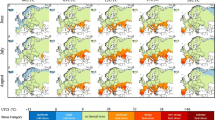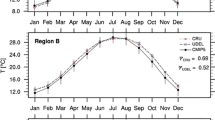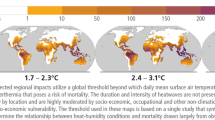Abstract
According to projections of climate models, air temperature will increase throughout the twenty-first century. The danger of heat exposure for the population is most severe in highly populated areas. Even relatively moderate levels of heat stress could be associated with adverse health impacts. Luxembourg, due to its high population density, is vulnerable to these effects. Up to now, no analysis of meteorological extreme values related to health impacts for the past and future climate conditions were available for Luxembourg. Climate indicators developed by the World Climate Research Programme's Expert Team on Climate Change Detection and Indices, as well as the physiological equivalent temperature were used to analyse data from (1) a long-term measurements side and (2) different regional climate models to assess potential health effects. In order to quantify the uncertainties related to climate change projections a multi-model ensemble of 16 projections from the ENSEMBLE Project at 25 km was used. In addition, a single model run with a spatial resolution of 1.3 km was conducted to analyse and quantify regional differences. The number of frost days is reduced by more than 40 days between the reference time-span and the last decade of this century. Tropical nights which did not occur in the reference time-span increased up to 11 events for the same time-span. The results for the physiologically equivalent temperature indicate a significant shift towards higher thermal stress levels for Luxembourg.





Similar content being viewed by others
References
Analitis A, Katsouyanni K, Biggeri A, Baccini M, Forsberg B, Bisanti L, Kirchmayer U, Ballester F, Cadum E, Goodman PG, Hojs A, Sunyer J, Tiittanen P, Michelozzi P (2008) Effects of cold weather on mortality: results from 15 European cities within the PHEWE project. Am J Epidemiol 168(12):1397–1408. doi:10.1093/aje/kwn266
Astrom DO, Forsberg B, Rocklov J (2011) Heat wave impact on morbidity and mortality in the elderly population: a review of recent studies. Maturitas 69(2):99–105. doi:10.1016/j.maturitas.2011.03.008
Baldauf M, Seifert A, Förstner J, Majewski D, Raschendorfer M, Reinhardt T (2011) Operational convective-scale numerical weather prediction with the COSMO model: description and sensitivities. Mon Weather Rev 139(12):3887–3905. doi:10.1175/mwr-d-10-05013.1
Beniston M, Stephenson D, Christensen O, Ferro C, Frei C, Goyette S, Halsnaes K, Holt T, Jylhä K, Koffi B, Palutikof J, Schöll R, Semmler T, Woth K (2007) Future extreme events in European climate: an exploration of regional climate model projections. Clim Chang 81:71–95
Christensen JH, Christensen OB (2007) A summary of the PRUDENCE model projections of changes in European climate by the end of this century. Clim Chang 81(S1):7–30. doi:10.1007/s10584-006-9210-7
Chotamonsak C, Salathé EP, Kreasuwan J, Chantara S, Siriwitayakorn K (2011) Projected climate change over Southeast Asia simulated using a WRF regional climate model. Atmos Sci Lett 12(2):213–219
de Vries H, Haarsma RJ, Hazeleger W (2012) Western European cold spells in current and future climate. Geophys Res Lett 39(4):L04706. doi:10.1029/2011gl050665
Donaldson G, Keatinge W (1997) Early increases in ischaemic heart disease mortality dissociated from, and later changes associated with, respiratory mortality, after cold weather in south east England. J Epidemiol Community Health 51:643–651
Donaldson K, Keatinge WR (2002) Excess winter mortality: influenca or cold stress. Obersational study. Br Med J 324(12):89–90
Fanger P (1972) Thermal comfort. McGraw Hill, New York
Gagge A, Fobelets A, Berglund L (1986) A standard predictive index of human response of the thermal environment. ASHRAE Trans 92:709–731
Goergen K, Beersma J, Hoffmann L, Junk J (2013) ENSEMBLES-based assessment of regional climate effects in Luxembourg and their impact on vegetation. Clim Chang 119(3):761–773. doi:10.1007/s10584-013-0756-x
Gutjahr O, Heinemann G (2013) Comparing precipitation bias correction methods for high-resolution regional climate simulations using COSMO - CLM. Theor Appl Climatol. doi:10.1007/s00704-013-0834-z
Hajat S, Armstrong B, Baccini M (2006) Impact of high temperatures on mortality: is there an added heat wave effect? Epidemiology 17:632–640
Hajat S, Kosatky T (2010) Heat-related mortality: a review and exploration of heterogeneity. J Epidemiol Community Health 64(9):753–760. doi:10.1136/jech.2009.087999
Hollweg H, Böhm U, Fast I, Hennemuth I, Keuler K, Keup-Thiel E, Lautenschlager M, Legutke S, Radtke K, Rockel B, Schubert M, Will A, Woldt M, Wunram C (2008) Ensemble simulations over Europe with the Regional Climate Model CLM forced with IPCC AR4 global scenarios. M & D Technial Report
Höppe P (1999) The physiological equivalent temperature—a universal index for the biometeorological assessment of the thermal environment. Int J Biometeorol 43:71–75
Huq S, Kovats S, Reid H, Satterthwaite D (2007) Editorial: reducing risks to cities from disasters and climate change. Environ Urban 19(1):3–15. doi:10.1177/0956247807078058
Insaf TZ, Lin S, Sheridan SC (2012) Climate trends in indices for temperature and precipitation across New York State, 1948–2008. Air Qual Atmos Health 6(1):247–257. doi:10.1007/s11869-011-0168-x
IPCC (2013) Climate Change 2013: The Physical Science Basis: Working Group I. Contribution to the IPCC fifth assessment report (AR5). Cambridge University Press, Cambridge
Jacob D, Göttel H, Kotlarski S, Lorenz P, Sieck K (2008) Klimaauswirkungen und Anpassung in Deutschland—phase 1: Erstellung regionaler Klimaszenarien für Deutschland, Umweltbundesamt Forschungsbericht. Umweltbundesamt, Berlin
Jacob D et al (2013) EURO-CORDEX: new high-resolution climate change projections for European impact research. Reg Environ Chang. doi:10.1007/s10113-013-0499-2
Junk J, Eickermann M, Görgen K, Beyer M, Hoffmann L (2012) Ensemble-based analysis of regional climate change effects on the cabbage stem weevil (Ceutorhynchus pallidactylus (Mrsh.)) in winter oilseed rape (Brassica napus L.). J Agric Sci 150(2):191–202. doi:10.1017/s0021859611000529
Kalkstein LS (1993) Health and climate change. Direct impacts in cities. Lancet 342(8884):1397–1399
Kalkstein LS, Green JS (1997) An evaluation of climate/mortality relationships in large U.S. cities and the possible impacts of a climate change. Environ Health Perspect 105(1):84–93
Karl T, Nicholls N, Ghazi A (1999) Clivar/GCOS/WMO Workshop on indices and indicators for climate extremes. Workshop summary. Clim Chang 42(1):3–7
Kilbourne EM, Choi K, Jones T, Thacker SB (1982) Risk factors for heatstroke: a case–control study. J Am Med Assoc 247(24):3332–3336. doi:10.1001/jama.1982.03320490030031
Kovats RS, Hajat S (2008) Heat stress and public health: a critical review. In: Annual Review of Public Health 29. Annual Review of Public Health. pp 41–55 doi:10.1146/annurev.publhealth.29.020907.090843
Matzarakis A (2013) Stadtklima vor dem Hintergrund des Klimawandels. Gefahrstoffe - Reinhaltung der Luft 73(3):115–118
Matzarakis A, Amelung B (2008) Physiological equivalent temperature as indicator for impacts of climate change on thermal comfort of humans. In: Thomson M, Garcia-Herrera R, Beniston M (eds) Seasonal Forecasts, Climatic Change and Human Health, vol 30. Advances in Global Change Research. Springer, Netherlands, pp 161–172. doi:10.1007/978-1-4020-6877-5_10
Matzarakis A, de Freitas C, Scott D (2007a) Developments in tourism climatology. 3rd International Workshop on Climate, Tourism and Recreation, Freiburg 2007
Matzarakis A, Mayer H (1996) Another kind of environmental stress: thermal stress. Newsletters. WHO Collaborating Centre for Air Quality Management and Air Pollution Control
Matzarakis A, Muthers S, Koch E (2011) Human biometeorological evaluation of heat-related mortality in Vienna. Theor Appl Climatol 105(1–2):1–10. doi:10.1007/s00704-010-0372-x
Matzarakis A, Rammelberg J, Junk J (2013) Assessment of thermal bioclimate and tourism climate potential for central Europe—the example of Luxembourg. Theor Appl Climatol. doi:10.1007/s00704-013-0835-y
Matzarakis A, Rutz F, Mayer H (2007b) Modelling radiation fluxes in simple and complex environments—application of the RayMan model. Int J Biometeorol 51(4):323–334. doi:10.1007/s00484-006-0061-8
Mayer H, Höppe P (1987) Thermal comfort of man in different urban environments. Theor Appl Climatol 38:43–49
Meehl GA, Terres J-M (2004) More intense, more frequent, and longer lasting heat waves in the 21st century. Science 305:994–997
Molitor D, Caffarra A, Sinigoj P, Pertot I, Hoffmann L, Junk J (2013) Late frost damage risk for viticulture under future climate conditions: a case study for the Luxembourgish winegrowing region. Australian Journal of Grape and Wine Research (in press)
Muthers S, Matzarakis A, Koch E (2010) Climate change and mortality in Vienna—a human biometeorological analysis based on regional climate modeling. Int J Environ Res Public Health 7(7):2965–2977. doi:10.3390/ijerph7072965
Nakićenović N, Swart R (2000) Special report on emissions scenarios: a special report of Working Group III of the Intergovernmental Panel on Climate Change. Cambridge University Press, Cambridge
Nastos PT, Matzarakis A (2011) The effect of air temperature and human thermal indices on mortality in Athens, Greece. Theor Appl Climatol 108(3–4):591–599. doi:10.1007/s00704-011-0555-0
Nuñez MN, Solman SA, Cabré MF (2008) Regional climate change experiments over southern South America. II: climate change scenarios in the late twenty-first century. Clim Dyn 32(7–8):1081–1095
Ott I, Duethmann D, Liebert J, Berg P, Feldmann H, Ihringer J, Kunstmann H, Merz B, Schaedler G, Wagner S (2013) High-resolution climate change impact analysis on medium-sized river catchments in Germany: an ensemble assessment. J Hydrometeorol 14(4):1175–1193. doi:10.1175/jhm-d-12-091.1
Piani C, Haerter J, Coppola E (2010) Statistical bias correction for daily precipitation in regional climate models over Europe. Theor Appl Climatol 99(1):187–192. doi:10.1007/s00704-009-0134-9
Rockel B, Will A, Hense A (2008) The regional climate model COSMO-CLM (CCLM). Meteorol Z 17(4):347–348. doi:10.1127/0941-2948/2008/0309
Tank A, Zwiers F, Zhang Y (2009) Guidelines on analysis of extremes in a changing climate in support of informed decisions for adaptation. World Meteorological Organization (WMO)
van der Linden P, Mitchell JFB (2009) ENSEMBLES: climate change and its impacts: Summary of research and results from the ENSEMBLES project. Met Office Hadley Centre, Exeter
VDI (1998) Methods for the human biometeorological evaluation of climate and air quality for the urban and regional planning. Beuth Vertrieb, Berlin
Wagner S, Berg P, Schädler G, Kunstmann H (2012) High resolution regional climate model simulations for Germany: part II—projected climate changes. Clim Dyn 40(1–2):415–427. doi:10.1007/s00382-012-1510-1
WMO (2009) WMO statement on the status of the global climate in 2009. World Meteorological Organization
Ylhäisi JS, Tietäväinen H, Peltonen-Sainio P, Venäläinen A, Eklund J, Räisänen J, Jylhä K (2010) Growing season precipitation in Finland under recent and projected climate. Nat Hazards Earth Syst Sci 10(7):1563–1574. doi:10.5194/nhess-10-1563-2010
Acknowledgments
Parts of the work have been performed in the framework of the “Small Particles—environmental behaviour and toxicity of nanomaterials and particulate matter” project. COSMO - CLM data were taken from the CLIMPACT Project funded by the National Research Fund of Luxembourg through grant FNR C09/SR/16. The authors also acknowledge the ENSEMBLES project, funded by the European Commission's 6th Framework Programme. Dr. L. Hoffmann is thanked for final manuscript draft reading as well as both reviewers for their constructive comments.
Author information
Authors and Affiliations
Corresponding author
Rights and permissions
About this article
Cite this article
Junk, J., Matzarakis, A., Ferrone, A. et al. Evidence of past and future changes in health-related meteorological variables across Luxembourg. Air Qual Atmos Health 7, 71–81 (2014). https://doi.org/10.1007/s11869-013-0229-4
Received:
Accepted:
Published:
Issue Date:
DOI: https://doi.org/10.1007/s11869-013-0229-4




